-Музыка
- Queen - The Show must go on
- Слушали: 16552 Комментарии: 0
- Очень красивая мелодия
- Слушали: 268322 Комментарии: 0
- Божья Коровка - "Гранитный Камушек"
- Слушали: 451 Комментарии: 0
- Demis Roussos-From Souvenirs to Souvenirs.
- Слушали: 21856 Комментарии: 0
- Снег кружится
- Слушали: 21015 Комментарии: 0
-Рубрики
- Вязание для женщин (2035)
- Кулинария (925)
- вышивка (638)
- Вязаные игрушки (451)
- Схемы вязания крючком (413)
- Схемы вязания спицами (354)
- Здоровье (333)
- Сапожки,пинетки,носки (325)
- Журналы по вязанию (320)
- Румынское кружево (266)
- вышивка гладью (242)
- Тапочки (175)
- Огород (139)
- Шитье(выкройки) (138)
- Сидушки на стулья (114)
- Интересные идеи (113)
- Компьютер (102)
- Канзаши (99)
- Сумочки (97)
- Плетение (89)
- Объемная вышивка (84)
- Джутовая филигрань (77)
- Барджелло (59)
- Пледы и покрывала (56)
- Вязаные цветы (55)
- Варежки,митенки (48)
- Тунисское вязание (48)
- Филейное вязание (47)
- Кожа и крючок (44)
- Для кухни (42)
- Фриволите (42)
- Поэзия (38)
- Музыка,клипы (37)
- Вязание с мехом (37)
- Песни,клипы (34)
- Трафареты (31)
- Свинг (31)
- Фильмотека (30)
- Шали (29)
- Мудрые мысли (28)
- ТУРЕЦКОЕ КРУЖЕВО (28)
- Молитвы (27)
- Ришелье (26)
- Плетение бисером (26)
- Вязание с мехом (25)
- ПРИХВАТКИ КОВРИКИ САЛФЕТКИ (25)
- Декупаж (22)
- Русский язык. (21)
- Носки (20)
- История (20)
- Вязание для мужин (20)
- Люневильская вышивка (19)
- Манишки,шарфы (19)
- Мудрость (16)
- Игольное кружево (15)
- Шарфы (15)
- Холодный фарфор (14)
- Вышивка детская (12)
- Идеи с мехом (12)
- Печворк (11)
- Наряды для кукол (11)
- валяние (10)
- Притчи (10)
- Раскраска (10)
- Шторы (10)
- Аудиокниги (9)
- Ковровая вышивка (9)
- Вязаная обувь (8)
- Валяние (8)
- Прически (8)
- Цветы (8)
- Программы для вязания. (8)
- Клипарт (7)
- Изонить (6)
- Шапки мужские (6)
- Квиллинг (6)
- Вышитая обувь (5)
- Сутажная вышивка (5)
- Мочила крючком (4)
- Якобинская вышивка (4)
- Юмор (4)
- Буфы (4)
- Мыло (4)
- Художники (4)
- О любви (4)
- Таблица размеров одежды (4)
- Машинная вышивка (3)
- Бразильская вышивка (3)
- Маникюр (3)
- Наш президент (3)
- Анимашки (3)
- Преводчик текста,программы (3)
- Учебники для обучения СССР (2)
- Квилтинг (2)
- Расчет обоев на комнату. Таблица и формула (2)
- Развитие речи (2)
- Библиотека (2)
- Брюггское кружево (2)
- Ганутель (2)
- Аватарки (2)
- Вязание на машине. (2)
- Норвежская вышивка (1)
- расширение шубы,дубленки (1)
- Вязание с Тулин (турция) (1)
- Счет на пальцах (1)
- Мир русского знахаря (1)
- Этикет в одежде (1)
- Манекен (1)
- Благодарности (1)
- Дизайн ногтей (1)
- Т.Устинова (1)
- Документальное кино (1)
- Ангелы-хранители (1)
- Мозаика из яичной скорлупы (1)
- Темари (1)
- Православный календарь (1)
- Сохранение дневника на Лиру (1)
- Калькуляторы для вязания (1)
- Норвежская вышивка (0)
- мини цветочки крючком от яп мастерицы (0)
- (0)
- (0)
- (0)
- (0)
- (0)
- (0)
- (0)
- (0)
- (0)
- вязание (503)
- Вязанные рюкзаки (3)
- Ирландское кружево (841)
- вязание для детей разное (1454)
- вязание для детей (1419)
- Разделители (1)
- Сайты по вязанию (2)
- Фриформ (128)
- Шапочки,шляпы (499)
-Поиск по дневнику
-Подписка по e-mail
-Постоянные читатели
-Сообщества
-Статистика
Записей: 11807
Комментариев: 162
Написано: 12152
Вытянутый французский узелок - техника вышивки |
The hand embroidery stitch called the pistil stitch (or the elongated French knot) comes in really handy when stitching flowers. The reason is obvious – it looks like its namesake, the pistil on the inside of a flower.
The pistil stitch is an easy stitch to master, and it works well inside all kinds of flowers or even on its own, in completely un-flower-related circumstances.
I’ve been using the pistil stitch on the Secret Garden project, on the flowers. Some reader’s have asked for pointers on working this stitch, so here’s a handy tutorial to show you how to work the pistil stitch.
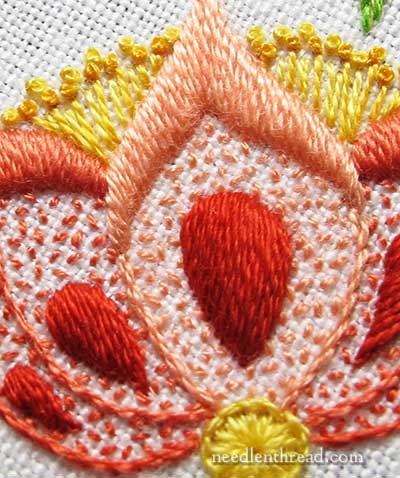 |
See the yellow “pistils” in these stylized flowers? Some of them – but not all – are pistil stitch. Some are simply straight stitches. Some are straight stitches topped with French knots. Whether I used a pistil stitch or just a straight stitch was determined by how much I wanted to fill the stalk area (where the straight stitches are), and whether or not adding another French knot in there or a pistil stitch would crowd the line too much.
In any case, here’s how the pistil stitch is worked:
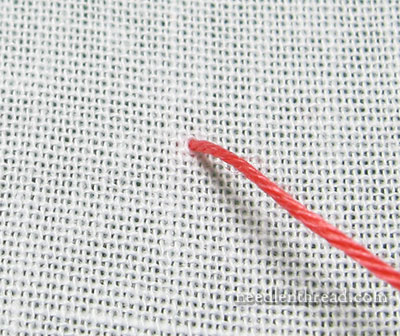 |
Bring the needle to the front of the fabric at the base of the pistil stitch – that is, the end of the stitch that does not have a knot on it.
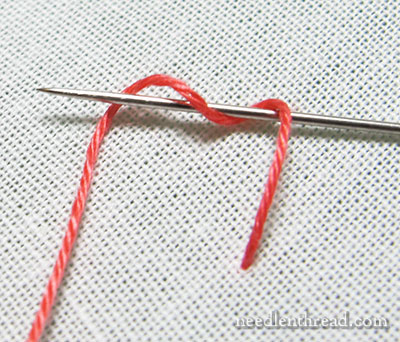 |
Wrap your thread around your needle, just as you would with a regular French knot.
I’m a Two-Wrap-French-Knot kind of gal, myself. Some people use three wraps, some people only use one (I find one wrap too small), and some people ask about using four or more.
I can see using three wraps when you’re attempting to get a really heavy knot, but the more wraps you put on the needle for a French knot, the more unruly the knot is going to be. I’d say three is the maximum threshold for a “ruly” knot, while four or more will tend more towards unruly.
Remember, there’s only one thread on one side of the knot holding the knot in place and in shape, so the more wraps you have flinging around unanchored except on the one side, the greater the chance the knot will fall out of shape, get snagged, or encounter other knotty problems.
In any case, back to the pistil stitch. Before I so rudely interrupted myself, we had some wraps on the needle…
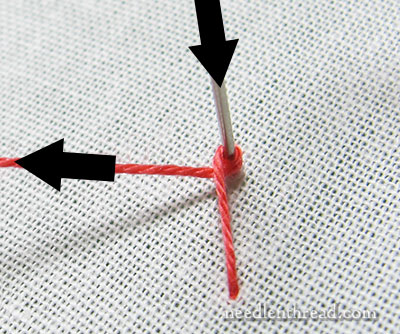 |
Keeping tension on the working thread (that’s the thread going off to the left in the photo above), take the needle down into the fabric wherever you want the knot on your pistil stitch to be. This will be at least a little distance away from where you began the stitch, so that, essentially, you end up with a straight stitch tail on the knot.
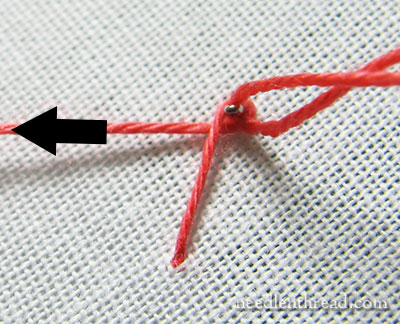 |
Pull the needle slowly down through the wraps, the whole while keeping tension on that working thread (where the arrow is pointing to the left in the photo above).
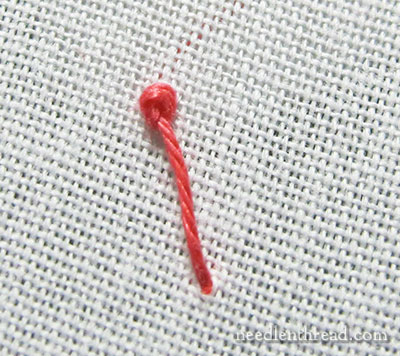 |
While still pulling the thread slowing through the fabric, let go of the working thread as your knot approaches completion.
The knot and tail won’t sit perfectly straight until you’ve begun your next stitch, or ended this one by anchoring the thread in the back of the fabric. In the photo above, the stitch is still a little loose, but once I start the next stitch, it will pull straight and snug.
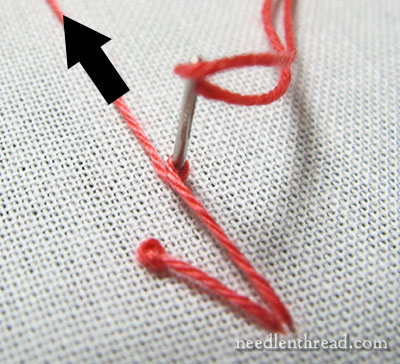 |
Here, I’m working on another pistil stitch. This time, I’m keeping tension on the working thread, pulling it up above the stitch. This will slightly change (but not much!) the orientation and look of the knot.
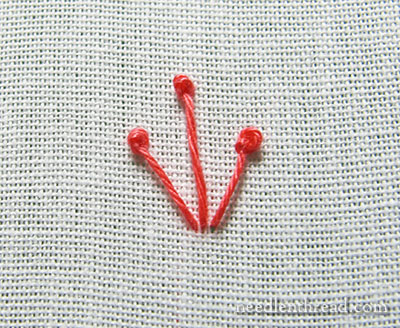 |
With the last pistil stitch on the right, I pulled the working thread all around to the right, and kept tension on it from the right side of the hoop. You can see that the knot on the right is slightly larger, because pulling the working thread all the way around to the right puts another half of a wrap into the knot.
So you can play around with where you hold your working thread when working a pistil stitch. It can make a slight difference in the look of the stitch, and you might like one approach better than another.
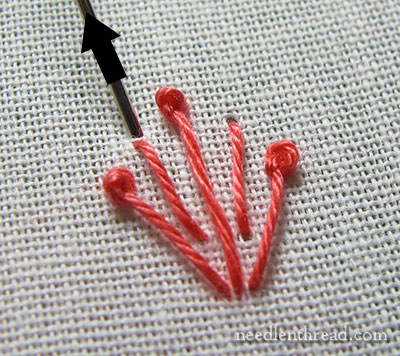 |
Here, I’ve worked two straight stitches between the pistil stitch.
I’m going to tip those with French knots. I’ve brought my needle up just one fabric thread away from the top of the straight stitch…
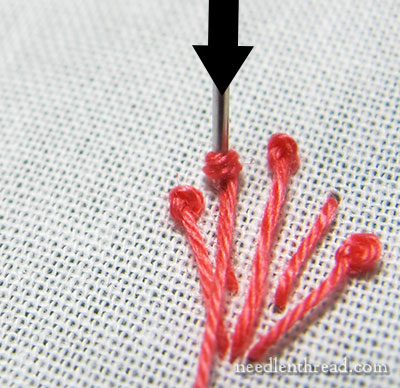 |
…and after making the wraps for the French knot, I’m taking it down into the fabric, in the same hole the straight stitch ended in.
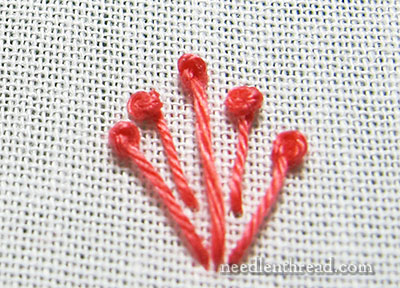 |
| Рубрики: | вышивка |
| Комментировать | « Пред. запись — К дневнику — След. запись » | Страницы: [1] [Новые] |






